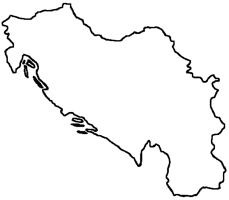
|
The Society of Folk Dance Historians (SFDH)
Choreogeography: Yugoslavia
[
Home |
About |
Encyclopedia | CLICK AN IMAGE TO ENLARGE |

|
 The late, great state of Yugoslavia is no more and probably never should have been. This "South Slav" state was a creation of the Treaty of Trianon in 1920, in which President Woodrow Wilson led the dismemberment of the Austro-Hungarian Empire following World War I.
The late, great state of Yugoslavia is no more and probably never should have been. This "South Slav" state was a creation of the Treaty of Trianon in 1920, in which President Woodrow Wilson led the dismemberment of the Austro-Hungarian Empire following World War I.
Mr. Wilson was not entirely well-informed about the make-up of the people of the region and based his concept of a new Europe strictly on language distribution, taking little note of the historical relationships between the various ethnic groups. If he had, the map would have been vastly different, resembling something like the currently evolving map of the area.
The seven states – Slovenia, Croatia, Bosnia-Herzegovina, Serbia, Kosovo, Montenegro, and Macedonia – had nothing in common except that they were Slavic peoples separated from the main Slavic world of Poland and Russia by the Hungarians and Romanians. As we shall see, they had more differences than similarities.
Utilizing our primary interest in folk dance, music, costume and folk arts, and fully realizing how closely they describe their cultures, a survey of each region will reveal much of those cultural differences of which Mr. Wilson was so unaware.
An important factor to note here is the distribution of line and couple dances across the country. The line dances are the oldest and appear in the regions occupied by the Ottoman Empire, which lasted from about 1390 to 1918 – some 500 years. The Turks resisted the influences of the European Renaissance of Italy and the north, that introduced the concept of couple dance. The line of influence can clearly be distinguished as one travels north to south.
REGIONS
Slovenia
Beginning in the north, Slovenia is a region whose folk life and arts more closely resemble those of Austria, its neighbor to the north. The southeren Alps extend into this region, now an independent state, and light-hearted polkas and waltzes played on the ubiquitous accordion are a sharp contrast to the kolos of Croatia and Serbia to the south.
Croatia
Croatia is probably the most widely varied region of all. In the region around Zagreb, the vigorous drmeš, with its trembling, staccato movements and brightly-hued tamburica music, is the dominant dance form, usually danced in circles, but frequently found in couples. In Slavonia, along the Hungarian border, the drmeš appears with some strong similarities to the Hungarian dance style. To the southwest, along the Adriatic Coast, Dalmatia evolved an entirely different form, as did the many islands just off-shore. Here, Italian influences in dance, music, and costume are very strong, not surprising considering it was easier to sail to Italy (and vice versa) than to climb over the rugged coastal mountains to the interior. Couple dances predominate, as does the presence of some very old stringed and wind musical instruments. One wonders just what tied the sprawling state of Croatia together.
Bosnia-Herzegovina
Croatia wraps around a region at the heart of the Yugoslav nation – Bosnia-Herzegovina. Its beautiful, rugged karst topography dooms the region to poverty, its people confined into long, narrow, infertile valleys. Generations of sheep and goats and the total destruction of forests to build ships for the old Venetian Empire leave little in the way of a progressive economy, not unlike our own remote Appalachian regions. An entirely unique, isolated dance form exists here, both line and couple dances, including several that represent the testing of the girls by the boys to ascertain if they are strong enough to endure the hardships of marriage!
Serbia
Serbia was a kingdom closely tied to Austria-Hungary, whether willingly or not. Its position as political center of the state of Yugoslavia served only to heighten the tensions between the Serbs and everyone else. An examination of Serbian dance and music reveals a much more serious approach than that of the Croatians, the brightly-hued, stringed music of the tamburica replaced with a more deliberate accordion and frula, a primitive shepherd's flute. A more "straight forward" style kolo is performed with utmost pride and dignity, emphasizing an elegant, precise footwork, rather than the Croatian's briliant virtuosity.
Vojvodina, in the north, is an autonomous republic of Serbia. The Bunjevci of Vojvodina are said to have migrated from the poor karst country of Bosnia-Herzegovina to the rich flatlands of Vojvodina, where they became one of the wealthier peasant cultures. Shunning the hand-worked embroidery of the "peasants," these uniquie people opted for expensive fabrics – silks, brocades, velvets, satins – to create some of the most elegant and expensive folk costumes in Europe. Their dance is elegant to the point of arrogance, restrained and dignified. The slight up/down movement of the serbian dance is there, but a curious element of Croatian brilliance is noted in the music and the men, wearing spurred boots, display a virtuosity in footwork rivaling that of Croatia. A very unique culture whose dance is found on both sides of the border with Hungary.
Kosovo
Kosovo is the traditional ex-patriat home of many Albanians who spilled out of their poor country over the centuries, giving us a glimpse of their complex dance style. These mountain-bred people have seemingly never heard of 2/4 rhythm and their dance is marked by not only irregular rhythms, but demanding technique favored by strong-legged mountain shepherds. Their music relies heavily on the Turkish heritage of 500 years of occupation.
Montenegro
Montenegro exists as an integral part of Serbia and its population is Serb. These unique mountain people (Montenegro = black mountain) were never conquered by the Turks and rarely lived beyond forty years of age in the days of the Empire. They are some of the tallest people in Europe, averaging well over six feet tall. Their height is accented by a beautiful costume featuring a coat with long vertical lines and a dance that consists of high vertical leaps opposite a partner – an impressive sight indeed.
Macedonia
In the south, Macedonia's ethnic region includes part of Bulgaria to the east and Greece to the south – a fact that causes friction to this day. Its mountainous terrain, in which many generations lived as guerilla fighters against the Turks, created a unique dance style with light, quick and irregular footwork, imitating the kinds of movements necessary for living on steep, rocky hillsides. Macedonia is indeed a very rich and varied region and its folklore has captured the hearts and admiration of many who were not born there.
IN CONCLUSION
So, from Austrian-style Slovenia to Italian-influenced Dalmatia to Hungarian-style Vojvodina to Albanian and Greek influenced Macedonia and the interior regions of Croatia, Bosnia-Herzegovina and Serbia, we see that this complex and fascinating corner of the world holds a valuable lesson in history, geography, folklore, and the human condition. It remains to be seen how much of its treasure of folk arts and traditions will survive. Perhaps we caught the last of it in our hands as lovers of their dance.
DOCUMENTS
- Balkans, a region.
- Richard Duree, an article.
- Yugoslavia, a country.
Used with permission of the author.
This page © 2018 by Ron Houston.
Please do not copy any part of this page without including this copyright notice.
Please do not copy small portions out of context.
Please do not copy large portions without permission from Ron Houston.